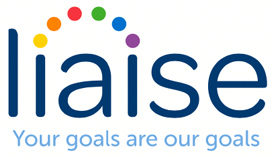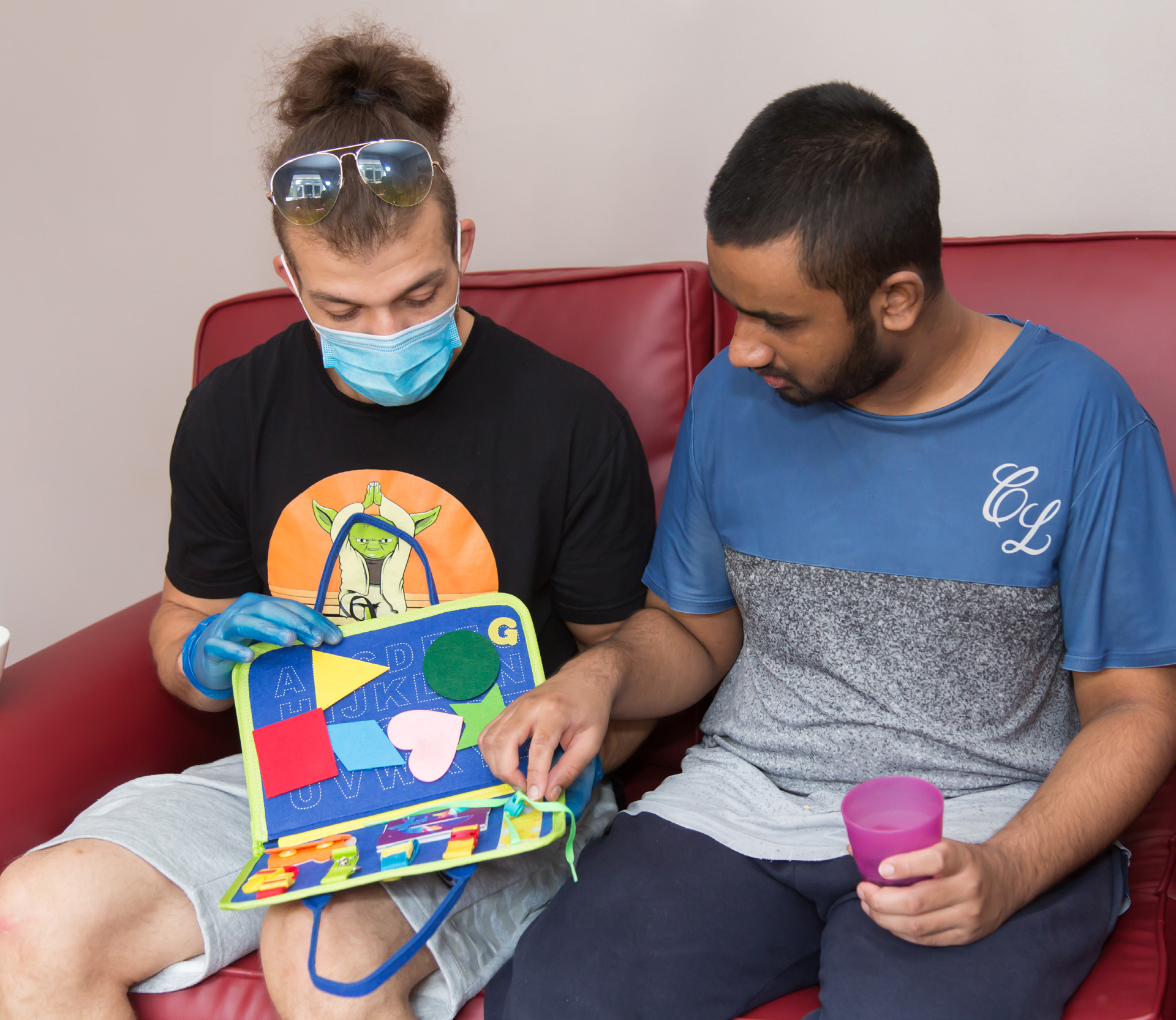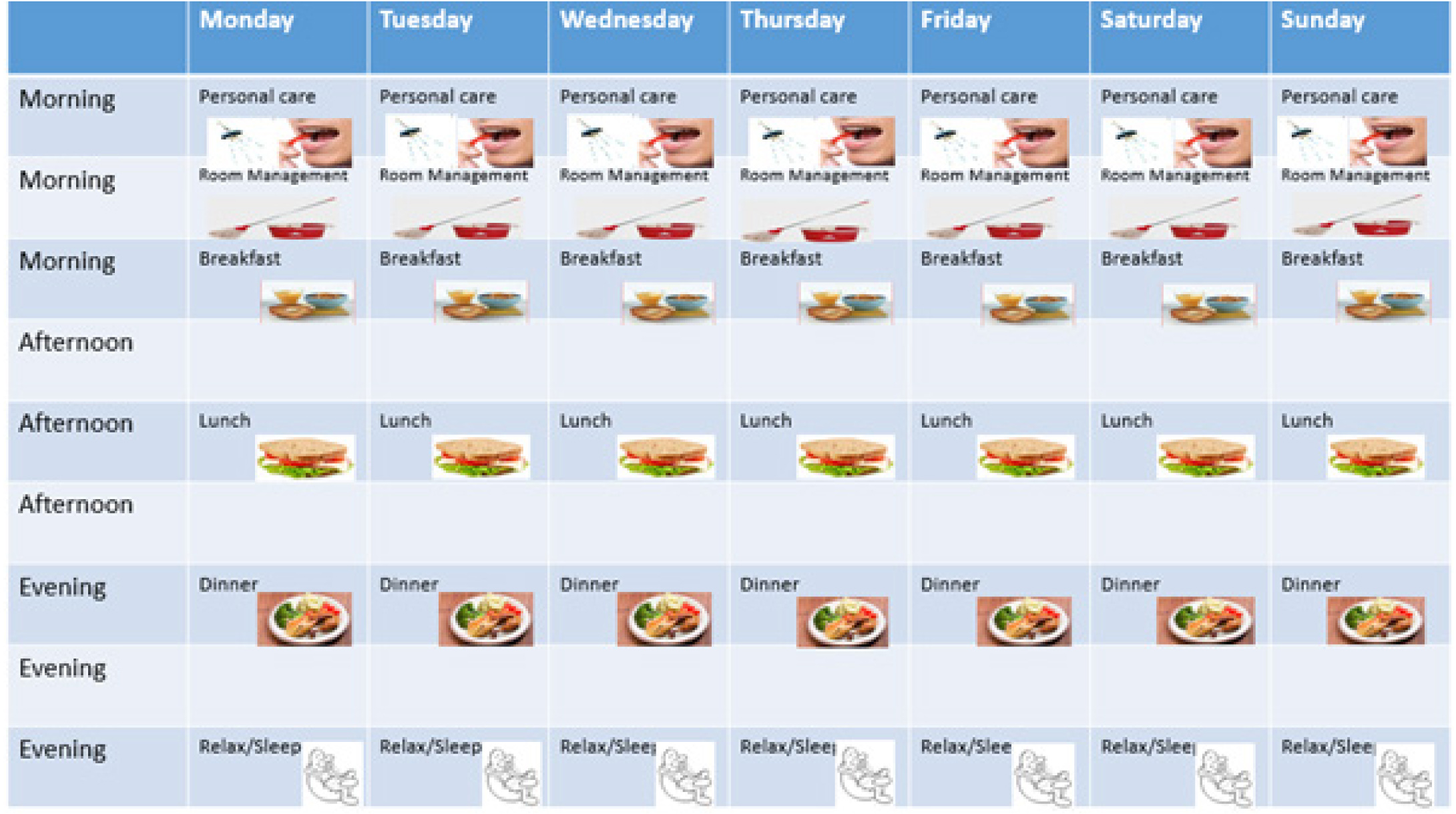Engagement Guidelines
Rationale: The following guidelines have been designed to aid support staff in building
rapport and engaging M in meaningful and rewarding activities. M may find it difficult to selfinitiate activities and may appear withdrawn/reserved/shy around staff members he does not know well. To speed up the process of establishing a connection and avoid M becoming bored, restless, disengage and potentially engage in behaviours that challenge:
- Staff working with M must be familiar with his care plans, risk ass, PBS plan, SALT and OT guidance. These give useful advice on how to have clear positive interactions with M and identify warning signs that M maybe struggling.
- M responds well to staff who are polite, respectful and friendly.
- At the start of the shift, the allocated member of staff should inform M that they are working with him. Ensure that M is clear about who is with him for the day.
- Offer M Planning time each morning. This is an opportunity for him to plan what to do that day. Please use one to one guidance provided and DOCUMENT.
- Activities – M may express that he would like to do- needs to or wants to do or enjoys doing certain activities such as art and craft, cooking and baking, trips out. Please add to the list of preferred activities as we get to know him and introduce a mix of needs to do, wants to do`s or enjoy doing during his day and week. Don’t forget to DOCUMENT
- M has a keen interest and will develop new ones e.g., in computers and tablets but can find them difficult to use. Staff can engage M by showing him how to look up places to go or do a virtual trip on google with him.
- Like anyone else M enjoys conversation around his particular areas of interest. These include electronics, Art/ craft and shopping. Please encourage those as much as you can and explore new ones.
- M may be reluctant to engage. Allow him his space but continue to check in and let him know you are there to talk/support, adapt demands/ grad activity, provide structure and predictability and DO activities with him.
- If you are still struggling to engage with M, ask to shadow a member of staff or MDT who M has a good relationship with or knows him better.
Some general tips to consider:
- Persistence M is likely to decline repeatedly new activities. This may be because he does not understand what is being offered or does not feel confident in participating. Alternatively, it may be an indication that M is a bit nervous so be reassuring and try and try again.
- Patience It may take several attempts for M to engage successfully. Allow M time to watch what you are doing or to leave after a short time until he starts to show greater confidence.
- Positivity Always appear enthusiastic and make activities look fun. Praise M every time he engages (e.g., ‘well done’, ‘you are very good at this’ Independent M etc.)
- Participation M is more likely to engage in activities if it is an opportunity to spend time with favourite members of staff. Staff should fully participate in the activity with M. Starting an activity and encouraging M to join in can be a successful method for engagement. Ensure you document and feedback on all activities M engages in and any changes in his activity participation.
- Participation Mert is more likely to engage in activities if it is an opportunity to spend time with favourite members of staff. Staff should fully participate in the activity with Mert. Starting an activity and encouraging Mert to join in can be a successful method for engagement.
Ensure you document and feedback on all activities Mert engages in and any changes in his activity participation.
As Mert is new to us all it is important that we spend time to get to know him. One of the things that we know that Mert loves is his one-to-one time, so to make the transition from home to his new home at Connington easier for him could you please ensure that you sit down with him every day in a nice a quiet area and have some nice one to one time with him.
- Playing cards
- Puzzles
- Listen to Music
- Cooking
- Showers
- Looking /reading the Books and the books that he has got from the Library
- Google virtual trips
- Plan day trips
- A Film
- Art and Craft
- Dancing
When engaging with Mert- Please remember that people can engage in meaningful activities in different ways:
- Doing the whole activity
- Doing part of the activity
- Continuous throughout activity
- Stop-start, dipping in and out of the activity
- Taking the lead role
- Joining in as an active participant
- Passive engagement
To ensure that Mert has a good time please- Grading the activity may be needed break down the activity/task into manageable steps.
Provide a clear sequence of how the task is to be performed.
If available use visual activity guide/ visual recipe.
If needed but not available please speak to a member of the OT team.
Grading makes the task more achievable increasing the person’s control and chances of succeeding.
What to be aware of when engaging with Mert:
Redirecting Mert`s attention to preferred activities like arts and craft
My computer/ iPad
Go for a walk
Watch movies/ music videos
If someone is having a difficult time take me somewhere else
Stick to my routine as it helps me
I don’t like animals
I don’t like to much noise
I don’t like waiting toooo long
To many changes in routine or plans a may find difficult.
I can find transition between activities difficult.
I need help in engaging in a range of activities and staying focused – I can concentrate without
problems for 15-20 min and on a good day much longer.
Plan my week sessions:
Mert is able to plan his week with support from staff.
Mert is to be supported to fill in his Weekly Planner each Monday and looked over each day to see if Mert would like to update it.
Staff are to encourage Mert to select a mix of activities.
Staff are to support Mert to make realistic choices surrounding time and length of activities.
Staff are to encourage Mert to make health choices, with weekly activities to include regular exercise.
Staff are to encourage Mert to be active to support his emotional well-being
Mert is to be encouraged to select a variety of activities, as Mert may expressed interest in a range of activities but can become pre-occupied by one thing/topic.
What can I do for myself- just to mention a few?
I can Dress and choose my cloths myself with
I can to Wash and shower myself with you help
I can to Clean and organise my room myself with your help
I can do cooking with your help
I like to Go shopping
And lots more
What do you need to be aware of when engaging with Mert?
I need prompts
I need LOTS of reassurance
I need to be given LOTS of time to Plan
I need time to be allowed to finish my rituals
I need personal time
I need to be listened to
I am very good at talking about or engaging in activities that is about my interests
I need you to ENCOURAGE me to get involved in actives. IN and outside of my room
I like to have a joke with people – I have a VERY good sense of humour
I might not talk to you but I understand and a listen to all that you say
I need help moving from one activity to the next- I can get anxious and need to finish one task before moving on to the next
I do not like changes in my routine
Lack of structure and routine
Feeling under pressure or have the feeling of being forced to do something
Overload of information
Key to Success
The Golden Rule
Does Mert need to do it?
Is he interested in it?
Keep it simple – gain attention, use simple/clear language
Have fun with it – use humour
Reduce demand and complexity – keep information to a ‘needs know basis’ making it easy for
Mert to know what is being asked of him and make it easy for him to make a start
Make the situation speak for itself – make it clear what is being offered and what Mert needs to do
Think about how the activity is presented
Below you will find some guidance on engagement Level of engagement
People can engage in meaningful activities in different ways:
Doing the whole activity
Doing part of the activity
Continuous throughout activity
Stop-start, dipping in and out of the activity
Taking the lead role
Joining in as an active participant
Passive engagement
Grading the activity
Break down the activity/task into manageable steps.
Provide a clear sequence of how the task is to be performed.
If available use visual activity guide/ visual recipe. If needed but not available please speak to a member of the OT team.
This makes the task more achievable increasing the person’s control and chances of succeeding.
Observations and Thoughts
Observations
What was easy?
What was difficult?
How could we have made this easier/harder?
What skills were used?
What was learnt?
MAKE SURE THAT YOU DOCUMENT AND SHARE.
How do we help? – and what Benefits are there
Develop independence in activities of daily living
How do we help?
Help to make achievable and realistic choices
Develop communication skills including: emotions, choice, rejection and pain
Develop skills e.g. money, community, social, meal preparation and many more
ENABLING MERT TO LIVE THE LIFE HE WOULD CHOOSE
Lene Vessey
Lene.vessey@sequencecaregroupcare.co.uk






